You might not realize how many everyday issues can lead to significant water damage in your home. From leaky roofs to faulty appliances, these problems can escalate quickly if not addressed. By identifying the top causes and implementing preventive measures, you can protect your property from costly repairs and health hazards. So, what are the main culprits behind water damage, and how can you effectively safeguard your home? Let's investigate these key factors and their solutions to guarantee you stay one step ahead.
Leaky Roofs
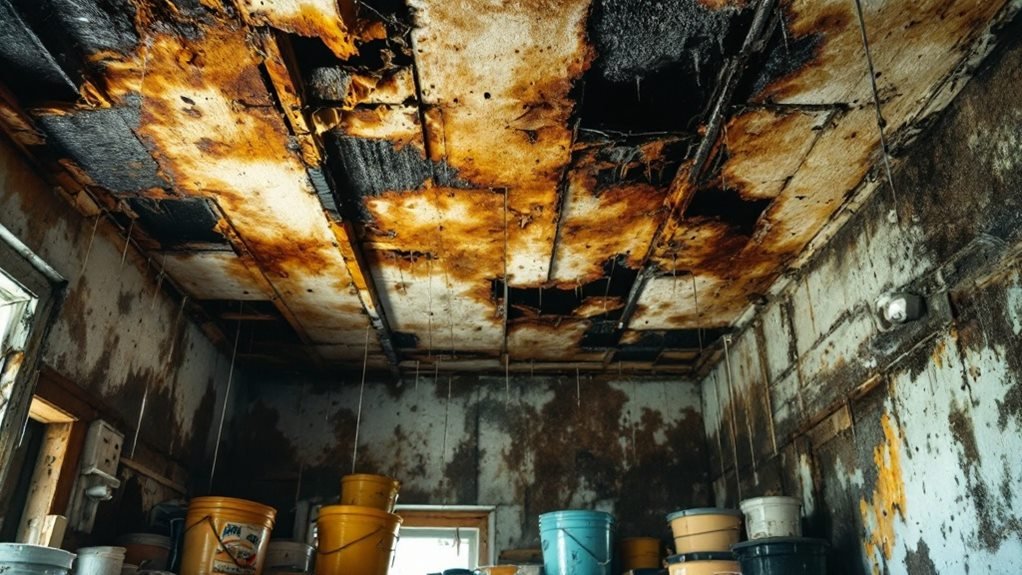
A leaky roof can lead to significant water damage and costly repairs if not addressed promptly. You might think your roof's just having a little "drip party," but trust me, it's no celebration when moisture creeps in. Regular roof inspections are your best defense against these unwelcome leaks. By catching potential issues early, you'll save yourself from the headache of replacing soggy drywall or, heaven forbid, that beloved vintage couch.
Moisture barriers are your roof's best friends; they help keep that pesky rainwater where it belongs—outside. Make sure your barriers are intact and functioning. If you notice wear, it's time to replace them before they turn into the last line of defense against a mini indoor waterfall.
Don't wait for the next storm to find out if your roof's ready for action! Schedule those inspections and give your roof the TLC it deserves. Remember, a proactive approach will keep you high and dry while avoiding the "water feature" that nobody wanted in their living room. So, keep that roof in check, and your home will thank you—probably by not turning into a swimming pool!
Broken Pipes
Broken pipes are a considerable cause of water damage in homes, often resulting from corrosion, freezing, or high water pressure. To protect your property, it's crucial to understand common pipe failures and implement preventive measures. By staying proactive, you can considerably reduce the risk of costly repairs and water damage.
Common Pipe Failures
When pipes fail, the consequences can be severe, leading to significant water damage and costly repairs. You wouldn't want your living room to turn into a swimming pool, would you? Understanding common pipe failures can save you from soggy situations. Here are three key culprits:
- Pipe Corrosion: Over time, pipes can rust and deteriorate, especially if they're made of metal. Once they start to corrode, it's like inviting a leak to your party.
- Pressure Changes: Sudden increases or decreases in water pressure can stress your pipes, causing them to crack or burst. Think of it as your pipes getting a bit too excited!
- Freezing Temperatures: If you live in a cold climate, water inside pipes can freeze, expand, and ultimately lead to a break. It's like your pipes are playing freeze tag, but they always lose!
Prevention Tips for Homeowners
Preventing pipe failures is crucial for protecting your home from water damage. First, keep an eye on your pipes like they're the last slice of pizza at a party. Regularly inspect them for leaks, corrosion, or signs of wear. You wouldn't ignore a suspicious noise from your car, right?
Next, consider insulating pipes in unheated areas. It's like giving them a cozy blanket for those cold winter nights—preventing them from freezing and bursting. And remember, water conservation isn't just good for your wallet; it helps reduce pressure on your plumbing system. So, fix those drips and save the planet one drop at a time!
In the domain of emergency preparedness, know where your main water shut-off valve is. If a pipe does burst, you'll want to be the superhero who can stop the flood before it starts. Finally, keep your gutters clean and guarantee proper drainage around your home. This helps divert water away from your foundation, reducing the strain on your plumbing.
Faulty Appliances
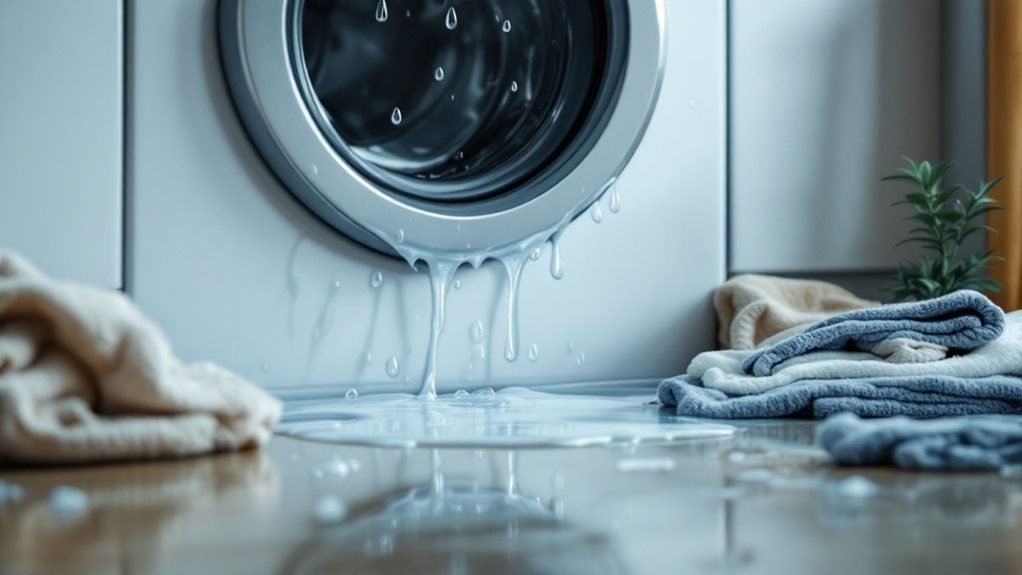
Faulty appliances can lead to significant water damage in your home if not addressed promptly. Common issues include leaks from dishwashers, washing machines, and refrigerators, which can go unnoticed until it's too late. Regular maintenance, such as checking hoses and seals, is crucial to prevent these problems from escalating.
Common Appliance Issues
Commonly, household appliances can become a significant source of water damage if they're not properly maintained. You might think your washing machine is just a spin cycle of joy, but it can likewise be a spin cycle of sorrow if you ignore issues. Here are three common appliance culprits to watch out for:
- Washing Machines: Those hoses can wear out faster than your favorite pair of socks. Check for leaks regularly to avoid a flood that could rival a small lake.
- Dishwashers: Clogged filters or faulty seals might make you think your dishwasher's just being dramatic—until you find a mini waterfall in your kitchen.
- Refrigerators: Ice buildup isn't romantic; it's a sign something's off. A malfunctioning defrost system can lead to leaks that could turn your kitchen into a slip 'n slide.
When you're considering appliance installation or appliance upgrades, verify you're investing in quality. A well-installed appliance can save you from a world of water woes. So, keep an eye on your appliances—or they might just get the last laugh!
Regular Maintenance Tips
Keeping your appliances in good shape is key to preventing water damage. Think of them as your home's unsung heroes; without regular maintenance, they can quickly turn into villains. Start with seasonal checkups. Just like you wouldn't skip your yearly physical, your appliances need attention, too. Check hoses for wear and tear; a fraying hose can lead to a mini Niagara Falls in your kitchen.
Don't forget about those exterior inspections! Look at the connections and seals around your appliances—if they're cracked or loose, it's time for a fix. Regularly clean your dishwasher filter and check your washing machine drum for lint build-up. Trust me, your appliances will thank you, and so will your floors.
Also, keep an eye on your water heater. Sediment build-up can cause leaks, so flush it out every few months. And remember, if you hear strange noises or see water pooling where it shouldn't, it's not just your imagination—your appliances are trying to send you a message! A little preventive maintenance goes a long way in keeping your home dry and your appliances happy.
Flooding
Flooding, often caused by heavy rainfall or storm surges, poses a significant threat to properties and infrastructure. It's like Mother Nature's way of saying, "Surprise!" Here are three things you should know to stay dry and safe:
- Know Your Flood Zones: Check if your property falls within a flood zone. If it does, consider it a permanent beach party—without the fun in the sun.
- Emergency Preparedness: Create an emergency plan and assemble a kit. Think of it as your "We're not drowning today" survival pack. Include necessities like water, food, and a canoe (just kidding… or am I?).
- Elevate Critical Systems: Keep your HVAC and electrical systems above ground level. It's like giving your appliances a VIP ticket to the water-free zone.
Clogged Gutters
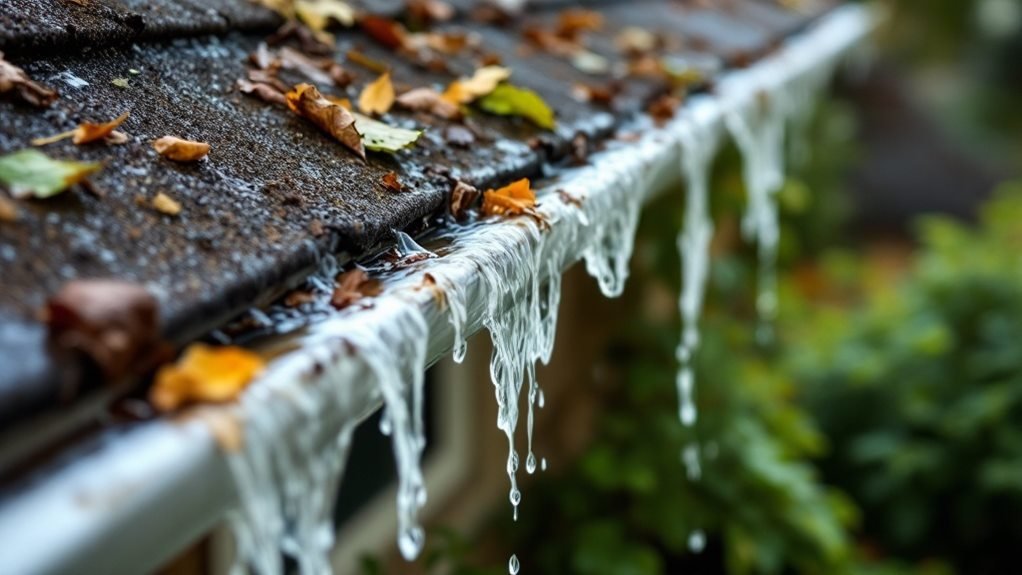
Clogged gutters can lead to significant water damage if not addressed promptly. Regular cleaning is vital to maintain proper water flow and prevent overflow, which can cause structural issues. Look for signs like water spilling over the edges or sagging sections to catch problems early.
Importance of Regular Cleaning
Regularly cleaning your gutters is essential for preventing water damage to your home. Ignoring this task can lead to a cascade of problems—literally! Here's what you need to keep in mind:
- Cleaning Frequency: Aim for at least twice a year, preferably in the spring and fall. Think of it as a seasonal spa treatment for your gutters—minus the cucumbers.
- Clogged Gutters: Debris like leaves and twigs can turn your gutters into a water park. When they're clogged, water has nowhere to go but over the edges, causing potential damage to your foundation.
- Cleaning Checklist: Use this handy checklist to stay organized:
- Remove debris and leaves
- Flush with water to guarantee proper flow
- Inspect for damage and rust
Signs of Clogged Gutters
Neglecting gutter maintenance can lead to noticeable signs that indicate a blockage. If you start to see water spilling over the sides of your gutters during a rainstorm, it's not a new water feature—it's a clear sign your gutters are clogged. Furthermore, if you spot sagging gutters, those are telling you they're too heavy with debris. Think of them as a sad hammock, drooping under the weight of leaves and twigs.
Another red flag? Pools of water forming near your foundation. When water flow is obstructed, it can create mini lakes that could eventually seep into your home. Yikes! You might as well notice an increase in pests, as clogged gutters can attract insects and rodents looking for a cozy nest.
Don't forget the dreaded moss or algae growth on your roof or walls. If your gutters aren't draining properly, they can create a perfect environment for these uninvited guests. So, keep an eye out for these signs. If you catch them early, you can tackle gutter maintenance before it turns into a water damage catastrophe!
Poor Drainage
Ineffective drainage systems can lead to significant water damage in both residential and commercial properties. When water doesn't flow where it's supposed to, it can create a cascading series of problems. Here are three common culprits of poor drainage:
- Clogged Gutters: If you've ignored those leaves and debris, your gutters are probably staging a water rebellion.
- Improper Terrain Grading: If your yard looks like a mini mountain range, water's going to take the path of least resistance—right into your foundation.
- Faulty Drainage Systems: Old, broken, or poorly designed drainage systems can't keep up with Mother Nature's whims.
To prevent water damage, take action now. Regularly clean your gutters and downspouts to keep them flowing freely. Verify terrain grading directs water away from your property, creating a gentle slope. And if your drainage systems are looking like they've seen better days, it might be time for an upgrade. Remember, you want your water to be outside, not staging a surprise party in your basement! By staying proactive with these steps, you'll keep your property dry and damage-free.
Foundation Cracks
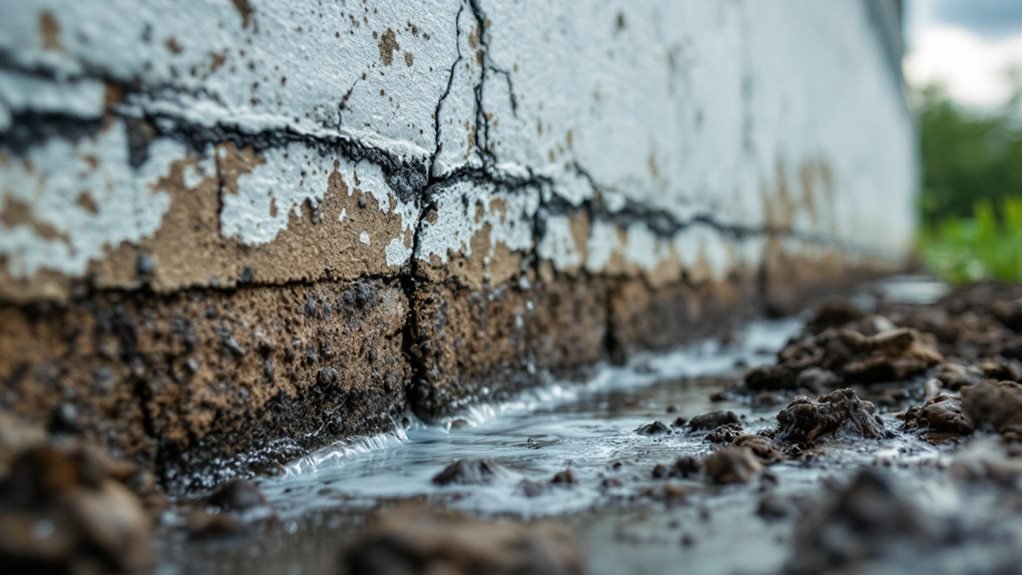
When poor drainage occurs, the consequences can extend beyond just water pooling around your property; it can lead to foundation cracks that compromise the structural integrity of your home. These cracks aren't just an aesthetic issue; they can invite water into your basement or crawl space, creating a cozy little habitat for mold and mildew. Not exactly the kind of roommate you want!
Foundation repairs can be costly, and nobody likes a surprise bill. So, what can you do? First, make certain your gutters are clean and directing water away from your foundation. If your yard resembles a swamp, you might have a soil erosion problem. Consider regrading your terrain to encourage drainage away from your home.
You could additionally install a French drain—no, not a fancy restaurant, but a drainage system that helps manage excess water. If cracks do appear, don't wait around for them to throw a party; seal them promptly to prevent further damage. Remember, your foundation's stability is no laughing matter, and taking proactive steps can save you from a watery disaster. So, get those cracks fixed and keep your home standing tall!
Humidity Issues
Humidity issues can wreak havoc on your home, leading to mold growth, structural damage, and uncomfortable living conditions. To keep your space cozy and dry, you should focus on effective humidity control. Here are three common culprits of high humidity:
- Poor Ventilation: Stale air loves to linger, trapping moisture and allowing mold to throw a wild party.
- Inadequate Insulation: Insulation's role isn't just to keep your home warm; it likewise helps regulate moisture.
- Leaky Pipes: A small leak can lead to a big mess, turning your home into a water park—minus the fun.
To combat these issues, consider installing moisture barriers in crawl spaces and basements. They act like the secret service for your home, keeping unwanted moisture at bay. Furthermore, a dehumidifier can be your new best friend, sucking up excess humidity faster than you can say "What's that smell?" By proactively managing humidity, you'll not only protect your home but likewise create a comfortable environment. So, don't let humidity rain on your parade—take control and keep your home dry!
Sewer Backups
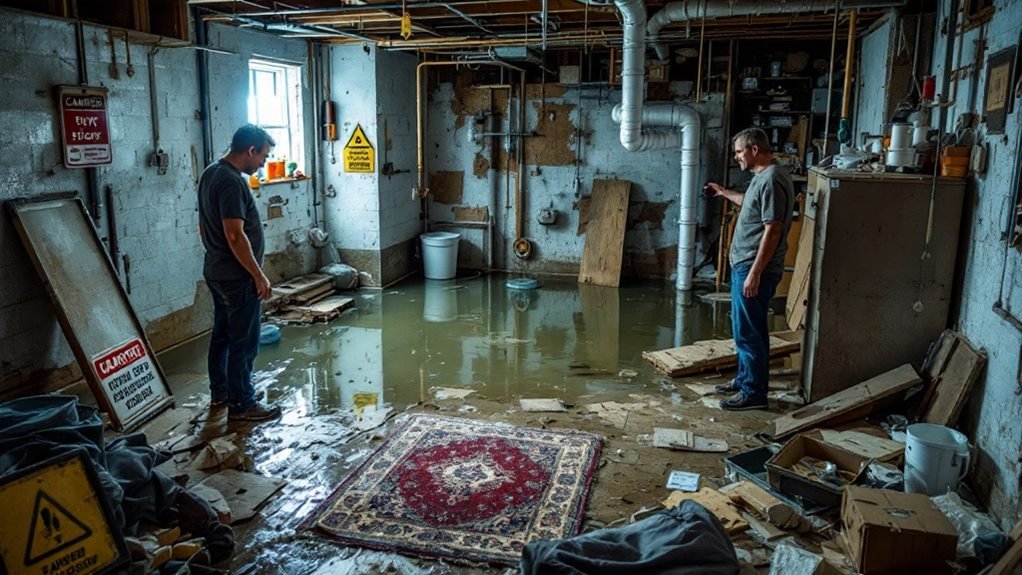
Controlling moisture levels is crucial, but unexpected sewer backups can also lead to severe water damage and health hazards in your home. You wouldn't want your living room to become the local swimming pool thanks to a sewer backup, right? Regular sewer inspections can help spot problems before they escalate, ensuring backup prevention is a priority.
Here's a quick breakdown of common causes and preventive measures:
| Cause | Prevention | Fun Fact |
|---|---|---|
| Clogged Drains | Regular Cleaning | You'll lose less hair in the drain! |
| Tree Roots | Root Barriers | Trees aren't just for shade! |
| Grease Buildup | Avoid Pouring Grease | Your pipes don't need a spa day! |
| Old Pipes | Routine Sewer Inspection | Old pipes aren't vintage wine! |
| Heavy Rainfall | Check Sump Pumps | Sump pumps: the unsung hero! |
Weather-Related Damage
Extreme weather events can wreak havoc on your home's structure, leading to significant water damage. From torrential downpours to hurricane winds, your lovely abode can become a soggy mess faster than you can say "flood insurance." Here are three weather-related issues you should watch out for:
- Heavy Rainfall: It can overwhelm gutters and downspouts, leading to leaks and basement floods.
- Snow and Ice Accumulation: When it melts, it can seep into cracks and crevices, causing extensive water damage.
- High Winds: They can compromise your roof, allowing rain to enter and wreak havoc inside.
To keep your home dry and damage-free, storm preparedness is key. Make certain your gutters are clean and your roof is in good shape. Consider investing in flood insurance, especially if you live in a high-risk area. It might seem like an unnecessary expense until you find yourself knee-deep in water, wishing you had that safety net. Remember, prevention isn't just better than cure; it's likewise a lot less messy!
Frequently Asked Questions
How Can I Identify a Hidden Leak in My Home?
Imagine a mischievous ghost lurking in your walls. To uncover hidden leaks, perform regular leak detection, inspect for damp spots, and schedule plumbing maintenance. Don't let that ghost haunt your home—find and fix those leaks!
What Insurance Covers Water Damage Repairs?
Most insurance policies cover water damage from specific events like burst pipes or storms. Check your policy details to verify your coverage's solid—because nothing's worse than finding out your insurance doesn't have your back when you need it!
How Often Should I Inspect My Plumbing?
You should inspect your plumbing at least twice a year. Regular plumbing maintenance and leak detection can save you from unexpected surprises—like your bathroom turning into a mini-water park. Trust me, you don't want that!
Are There Specific Plants That Help Reduce Indoor Humidity?
Humidity-loving plants, like peace lilies and spider plants, can boost indoor air quality while absorbing excess moisture. So, if you want a healthier home, let these green buddies help you breathe easier and thrive!
What Are the Signs of Mold After Water Damage?
After water damage, you'll notice musty odors, discoloration, and visible growth. For effective mold prevention, conduct a thorough mold inspection. Trust me, ignoring these signs is like inviting a mold party you definitely don't want!
Conclusion
To summarize, effectively managing the top causes of water damage is like building a sturdy dam against the relentless tide. By staying proactive with inspections and maintenance, you can protect your home from potential disasters. Regularly check your roof, plumbing, and appliances, and guarantee proper drainage. Remember, a little prevention today can save you from costly repairs tomorrow. Don't wait for the storm to hit; take action now and safeguard your investment.

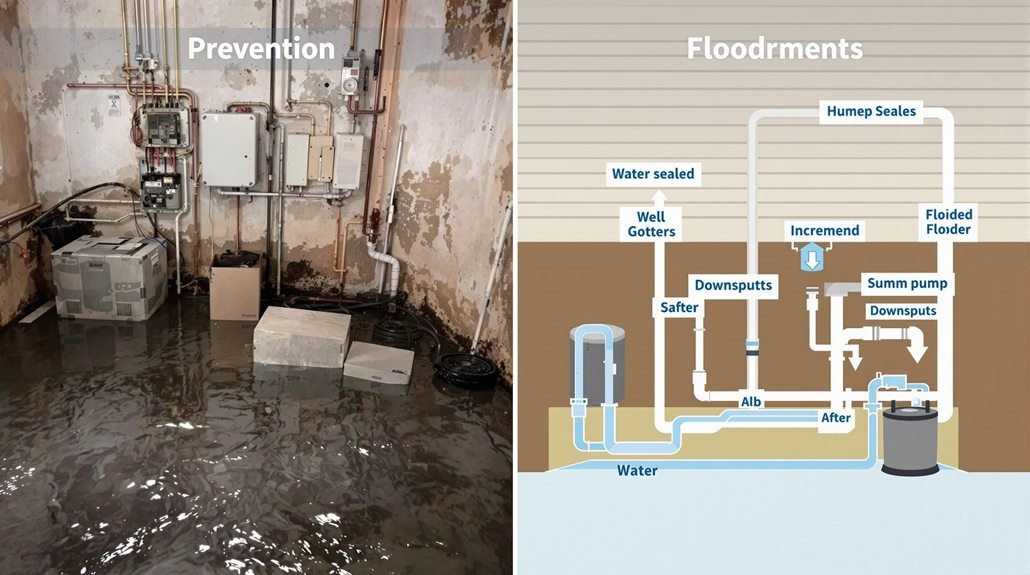
Recent Comments